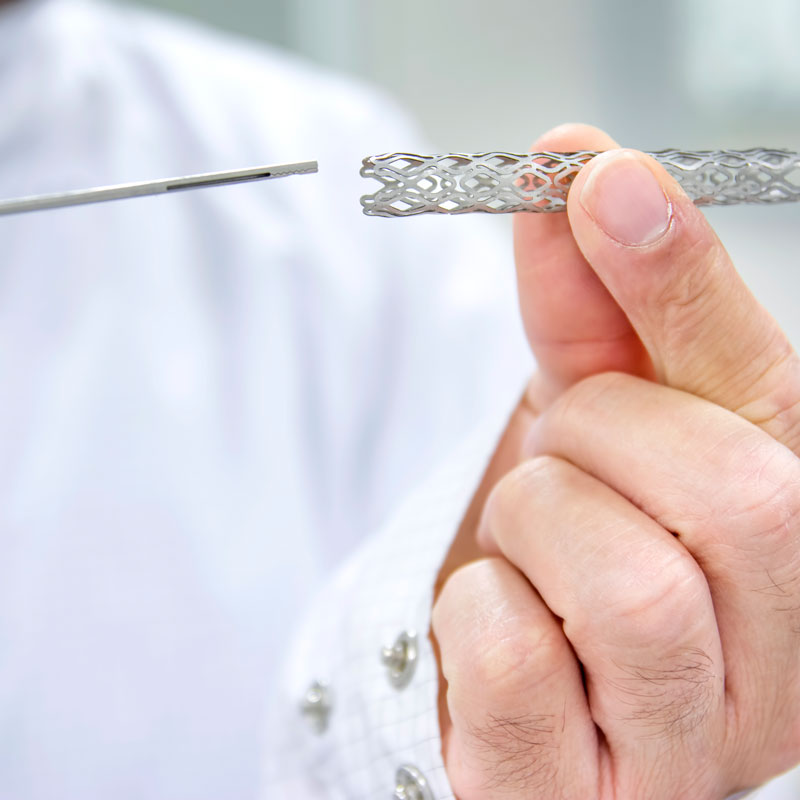Angioplasty With Stent Placement
Angioplasty With Stent Placement in Arizona
If a medical provider or specialist has diagnosed you with a coronary artery blockage, you may need an angioplasty with stent placement in Arizona. An angioplasty procedure opens narrowed or blocked blood vessels to allow unrestricted blood flow to the heart. A stent is a small, metal mesh tube placed during or right after an angioplasty to prevent the artery from closing again. Arizona Vein & Laser Institute has highly skilled medical specialists and cardiovascular surgeons at each of our six locations. We specialize in diagnosing and treating venous and vascular disorders and diseases. Call us today to schedule a consultation for angioplasty with a stent placement procedure.
What Is an Angioplasty?
An angioplasty is a minimally invasive surgical procedure that creates more space inside an artery. You may need to undergo an angioplasty if you have plaque buildup inside your artery walls. Plaque buildup can restrict blood flow to the heart and increase your risk of a stroke or heart attack. During an angioplasty, our surgeon will use a small balloon to force the plaque against the artery walls so blood can pass through safely.

When is an Angioplasty With Stent Placement Needed?
If an atherectomy is unsuccessful or can’t be safely performed, your doctor may recommend an angioplasty with stent placement. An angioplasty procedure is often performed alongside an additional procedure to place a small wire mesh tube called a stent. A stent holds the artery open and reduces the risk of it narrowing again. Many stents are coated with a medication that helps keep the artery open. You may need an angioplasty with stent placement treatment if you have atherosclerosis or blocked arteries, chest pain, and shortness of breath. We may recommend an angioplasty with stent placement if:
- Other treatments, lifestyle changes, and medications have been ineffective.
- You have worsening chest pain and/or shortness of breath.
- You have a heart attack.
Angioplasty With Stent Placement Procedure
An angioplasty with a stent placement procedure is performed through an artery in your groin, arm, or wrist. You will not go under general anesthesia. Instead, you will get a sedative to help you relax, but you will be awake during the procedure. You will also receive fluids and blood thinners through an IV. Your heart rate, pulse, blood pressure, and oxygen levels will be carefully monitored during the procedure. Your surgeon will apply an antiseptic solution to the incision area and place a sterile sheet over your body. They will then numb the area with a local anesthetic, make a small incision, and guide a small, thin wire into your blood vessel. Using live X-rays, they will then thread a catheter through your artery. They will inject contrast dye through the catheter to see inside the blood vessels and identify blockages. Then they will inflate a small balloon with a stent at the tip of the catheter at the blockage to widen the blocked artery. When the artery is stretched, the balloon is deflated, and the catheter is removed. The procedure is performed at each blockage.

Preparing for Angioplasty With Stent Placement
Before you undergo an angioplasty with a stent placement procedure, your surgeon will give you careful preparation instructions. They will review your medical history, perform testing, and complete a physical exam. You will likely undergo a coronary angiogram to assess the extent of the blockage of your coronary arteries. This procedure requires that a catheter be inserted into the heart, so if your surgeon determines that the blockage is severe enough, they may proceed with performing an angioplasty with stent placement at that same time. Before your procedure, your doctor or surgeon may recommend that you:
- Stop taking aspirin, NSAIDs, blood thinners, and some herbal supplements.
- Refrain from eating or drinking at least six to eight hours before the procedure.
- Take approved medications with only small sips of water.
- Take all your medications with you to the procedure.
- Prepare for an overnight stay in the hospital or medical facility.
- Find someone to drive you home the day after the procedure.
What to Expect After the Procedure
After an angioplasty with stent placement treatment, your doctor will prescribe medications to thin your blood and reduce the risk of blood clots. You will remain at the hospital overnight, and your heart will be monitored carefully. You will need to refrain from stress, work, and heavy lifting for at least a week after the angioplasty procedure. When you return home, drink plenty of clear fluids and avoid strenuous exercise and lifting heavy objects for at least one day. Watch for signs of bleeding or swelling around the site where the catheter was inserted, pain or discomfort, signs of infection, faintness or weakness, and chest pain or shortness of breath.
Schedule a Consultation With Our Specialists
Call us today or contact us online to schedule a consultation with one of our specialists for an angioplasty with stent placement procedure at Arizona Vein & Laser Institute. We have six convenient locations in Mesa, Chandler, Surprise, Avondale, Glendale, and Phoenix, AZ. Our medical specialists and cardiovascular surgeons have decades of experience in diagnosing and treating vascular and venous disorders and diseases. Call us today to ask for a same-day appointment.
